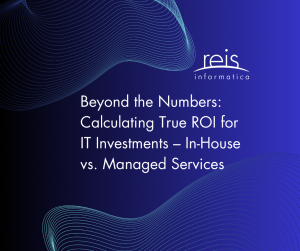IT investments are no longer optional—they’re essential. Yet many organizations struggle with a fundamental question: Is it more cost-effective to manage IT in-house or partner with an IT-managed service provider (MSP)? The answer lies in understanding the nuanced differences in how ROI should be calculated for each approach.
The Hidden Dimensions of In-House IT ROI
When evaluating the return on investment for in-house IT, businesses must look beyond the obvious expenses. While salaries, hardware, and software costs are straightforward line items, the true ROI calculation requires a more comprehensive view.
In-house IT investments typically involve significant upfront capital expenditures followed by ongoing operational costs. The ROI timeline tends to be longer, with benefits materializing gradually as internal teams develop expertise and processes. Organizations must account for the complete lifecycle of their technology investments, including:
- The full burden cost of specialized IT talent acquisition and retention
- Coverage limitations and their impact on business continuity
- Time diverted from core business activities to manage technology
- The opportunity cost of capital tied up in IT infrastructure
- Technology obsolescence and refresh cycles
This approach to ROI calculation often reveals that what initially seems cost-effective can become increasingly expensive over time, especially as technology requirements grow more complex.
The MSP Approach to ROI Calculation
Managed IT services provide a different approach on how technology investments should be evaluated. Instead of measuring returns against large capital expenditures and variable operational costs, the MSP model shifts the calculation to a more predictable subscription-based framework.
The ROI calculation for managed services incorporate several distinct advantages:
-
Operational Expense Model
MSPs convert unpredictable capital expenditures into stable monthly operational expenses. This shift allows for more accurate budgeting and frees up capital for core business investments, creating a different ROI calculation methodology that values predictability and cash flow optimization.
-
Scale and Specialization Benefits
While in-house IT ROI is limited by the expertise of a few individuals, MSP calculations must account for the value of accessing diverse technical specializations on-demand. The ability to scale resources up or down based on actual needs creates a fundamentally different value proposition than maintaining fixed internal resources.
-
Business Continuity Considerations
The ROI framework for managed services must incorporate the value of business continuity protection. Unlike in-house approaches where coverage gaps represent significant risk exposure, the MSP model provides consistent coverage and proactive monitoring that reduces potential downtime—a critical factor in accurate ROI assessment.
-
Strategic vs. Tactical Focus
Perhaps the most significant difference in ROI calculation approaches is how each model impacts your organization’s strategic capabilities. In-house IT often becomes consumed with day-to-day maintenance, whereas MSPs can provide both tactical support and strategic guidance. This shift allows internal resources to focus on business-specific innovation rather than infrastructure maintenance.
Choosing the Right ROI Framework
When evaluating these different approaches, organizations should consider several factors:
- Business goals and how each model provides flexibility in accommodating scaling both up and down
- The strategic importance of technology to your competitive advantage and the knowledgeable assets available to provide guidance, analysis and roadmapping.
- Risk tolerance, especially regarding security and compliance
- The value placed on predictable IT expenses versus variable costs
- The opportunity cost of management attention devoted to IT challenges
The key insight is that ROI calculations for technology investments aren’t one-size-fits-all. Organizations must adapt their analysis approach based on whether they’re evaluating in-house resources or managed services partnerships.
Looking Beyond Traditional ROI Metrics
Ultimately, the most effective ROI calculations for IT investments—whether in-house or outsourced—need to incorporate both quantitative metrics and qualitative business benefits. The right approach isn’t solely determined by which option costs less, but which creates the most sustainable competitive advantage through technology enablement.
By understanding these fundamental differences in ROI calculation approaches, business leaders can make more informed decisions about the true value of their technology investments and how best to structure them for maximum return.
About Reis Informatica
Reis Informatica specializes in managed IT services and cybersecurity solutions for small and medium-sized businesses (SMBs) across Ontario, including Toronto, Kitchener, Waterloo, Guelph, and Ottawa. With 20+ years of experience, we provide IT support, cloud solutions, network security, and data backup to help businesses stay secure and efficient. Our proactive approach minimizes downtime, enhances cybersecurity, and ensures your technology aligns with business goals. Start for Free – Contact Reis Informatica today for customized IT solutions that help your business thrive.

